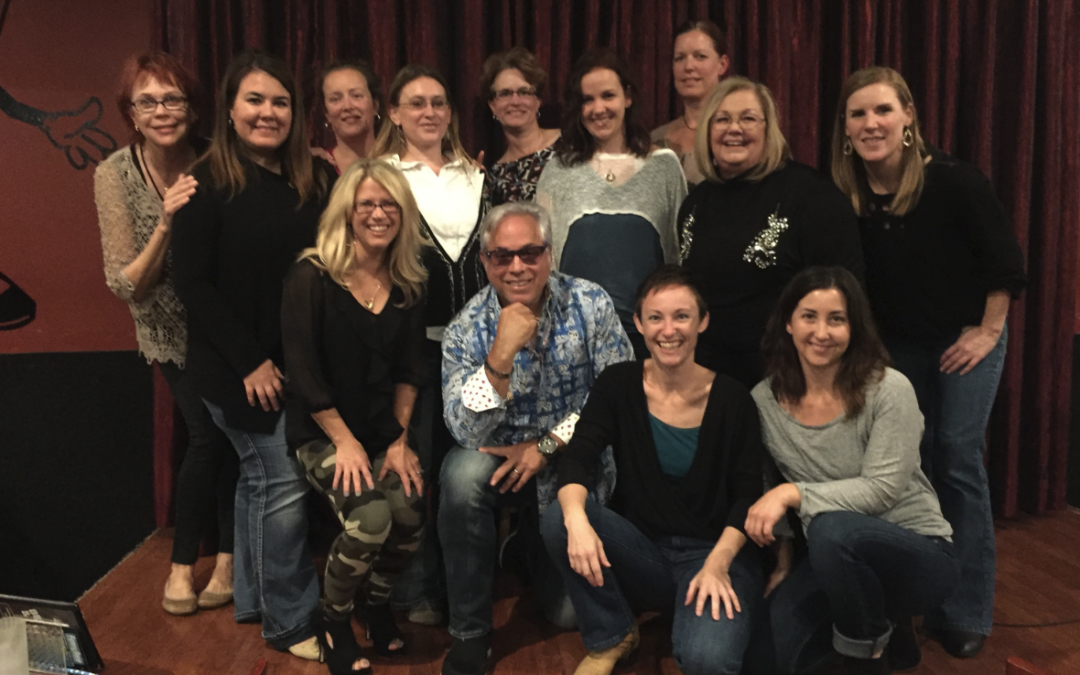Willie Ferrell with Me and some friends celebrating my 41st birthday.
One of my best friends manages a comedy club so I have celebrated just about anything there is to celebrate at the club.
I even tried to induce labor with my first child by going to a hypnotist show.
While it didn’t actually induce labor, it did make my last night of pregnancy much more enjoyable.
I tend to be serious in demeanor. I recognize that. I enjoy being around people who are laughing and enjoying themselves.
However, it’s not always easy for me to let go and STOP thinking long enough to let an emotion like joy or amusement take over.
Which is why I appreciate the experience of stand-up comedy!

Pete Lee with the family.
Believe it or not, my significant other has labeled me a tough critic of comedy. I will admit, it’s true. I have seen a lot of comics over the years and I know what kinds of things make me laugh and what just doesn’t amuse me.
Old episodes of Friends make me laugh out loud. 🤣 Where most of the time I find Will Ferrell annoying. 🙄 Any type of prank show whether it’s a fake phone call or a simulated situation makes me extremely uncomfortable. 🫣
While I take my comedy seriously, I recognize the importance of letting go of thinking and just feeling.
So I always enjoy an evening out watching a stand-up because laughter is contagious. I can be in a crappy mood but put me in a room full of laughing people and it shifts my mood. I know there is a therapeutic value in laughter.
We have all heard of the saying:
“Laughter is the best medicine.”
And like most cliches, there is real fundamental truth to it.
Laughter as medicine has been the subject of research in various fields, including psychology, neuroscience, and medicine. The scientific study of laughter’s therapeutic effects is often referred to as “gelotology.” Gelotologists have found all sorts of benefits of laughter:
- Pain Relief: Research has shown that laughter can increase pain tolerance and reduce the perception of pain. This effect is attributed to the release of endorphins, the body’s natural painkillers, during laughter.
- Stress Reduction: Laughter is known to reduce stress hormones like cortisol, leading to a relaxation response in the body. Regular laughter can contribute to long-term stress reduction.
- Immune System Enhancement: Studies have indicated that laughter can stimulate the production of immune-boosting antibodies and activate immune cells. This suggests that laughter may help the body defend against infections and illnesses.
- Cardiovascular Benefits: Laughing can lead to the dilation of blood vessels, which improves blood flow and can reduce the risk of heart disease. It can also lower blood pressure temporarily.
- Emotional Well-being: Laughter is associated with improved mood and decreased symptoms of depression and anxiety. It promotes a sense of well-being and can be used as complementary therapy for mental health issues.
- Social Bonding: Shared laughter fosters social connections and strengthens relationships. This can have positive effects on mental and emotional health.
- Cognitive Benefits: Laughter may enhance cognitive function, including creativity and problem-solving skills. It can also improve memory retention.
- Pulmonary Benefits: Laughter can increase lung function by enhancing oxygen exchange, potentially benefiting individuals with certain respiratory conditions.
But when you just aren’t feeling it, laughter can’t be forced.
OR CAN IT?
There is actually research out there that says that non-spontaneous laughter has the same effect on our bodies as the real thing. You do not have to feel the urge to laugh in order to derive the physiological and psychological benefits of laughter.
The basic idea behind “laughter therapy” is that laughter, even when simulated or forced, can have many of the same benefits as spontaneous laughter.

Shawn Gnandt and myself
Laughter therapy, also known as laughter yoga or laughter meditation, is a practice that involves intentional, voluntary laughter to promote physical, mental, and emotional well-being. It was developed by Dr. Madan Kataria, a physician from India, in 1995.
Here’s how laughter therapy typically works:
Laughter Exercises
Participants engage in various laughter exercises and activities led by a laughter therapist or facilitator. These exercises often involve playful and humorous movements, clapping, and chanting.
Forced Laughter
Participants are encouraged to initiate laughter voluntarily, even if they don’t feel like laughing initially. This forced laughter often becomes genuine as the group engages in contagious laughter.
Laughter Meditation
The session may end with a period of relaxation and guided meditation to help participants experience a sense of calm and well-being.

Dusty Slay with me and mom.
Incorporating laughter into our lives, whether through comedy clubs, laughter yoga, or simply enjoying humorous moments, can contribute to improved overall well-being and a more positive outlook on life.
LAUGHTER REALLY IS MEDICINE.
In the clinic, I often work with people carrying heavy emotions: loss, grief, trauma, as well as chronic, persistent, and unrelenting pain.
Release of emotion that is stored in the body can come out in many forms:
It can be quietness and stillness with internal processing.
It can be tears… many times for seemingly unknown reasons. Sometimes tears aren’t connected to a memory or fear but simply an outward release.
And also laughter. I have seen firsthand that laughter is absolutely therapeutic. An emotional release that involves laughter can be felt deeply and be very profound.
Emotional release really does affect our physical and mental well-being.
But it’s hard to know how to get to an emotion that needs releasing. This is why Somato Emotional Release is such a beautiful thing.
Somato Emotional Release (or SER) is a technique that is based on the idea that emotional and psychological experiences can be stored in the body and may manifest as physical symptoms or discomfort.
The SER process, using manual therapy techniques like CranioSacral Therapy, aims to release these emotions and promote healing. While crying is a well-known and natural way to release emotions and often accompanies emotional healing, laughter can indeed be a powerful and positive release as well.
And believe me, I have seen the full range of emotions released on my treatment table.

Tammy Pescatelli with me and my significant other.
If you are looking for help with pain or illness or suspect there is physical, emotional, or psychological trauma stored in your body, I would love to assist you in your healing.
Get started by scheduling a free 15-min discovery call.
Returning clients, book an appointment by logging into your account.

